
German postcard by Verlag Hermann Leiser, Berlin-Wilm., no. 9667/1. Photo: DBG (Deutsche Bioscop-Gesellschaft). Publicity still for Homunculus, 1. Teil/Homunculus (1916).
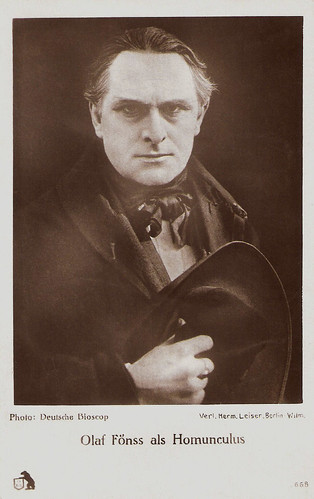
German postcard by Verlag Hermann Leiser, Berlin-Wilm., no. 9668. Photo: DBG (Deutsche Bioscop-Gesellschaft). Publicity still for Homunculus, 1. Teil/Homunculus (1916).
Little human
After having played in Danish films in the early and mid-1910s, Olaf Fönss tried his luck in Germany in 1915.
He immediately became the protagonist of the serial Homunculus, written by Robert Reinert, directed by Otto Rippert and released in 1916.
The script was written by Fritz Lang, and the film foreshadows various elements of his film Metropolis (Fritz Lang, 1929), which will be the subject of EFSP's film special next Sunday.
Homunculus is an artificial creature, test tube bred in a lab by Dr. Hansen (Theodoor Loos) and his assistant Edgar Rodin (Friedrich Kühne). They call their created baby 'Homunculus', Latin for 'little human.
Homunculus is brought up thinking he is a normal man. After learning of his true identity, the adult Homunculus understands he has no soul and is incapable of love. He hates Hansen for making him. Hansen's daughter loves Homunculus, but he is unable to feel much beyond hate.
Homunculus leaves, haunted by the incapability to feel human emotions. During his travels, he adopts a stray dog, feeling pity - if not love. He instigates revolutions and becomes a monstrous but beautiful tyrant, relentlessly pursued by his creator-father who seeks to rectify his mistake.
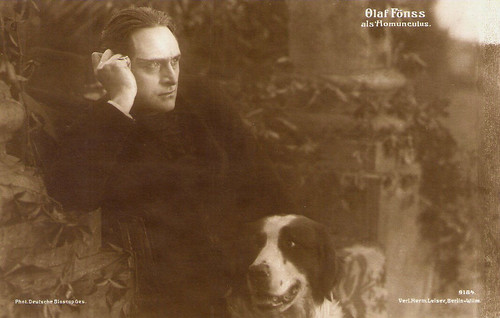
German postcard by Verlag Hermann Leiser, Berlin-Wilmersdorf, no. 9184. Photo: DBG (Deutsche Bioscop-Gesellschaft).
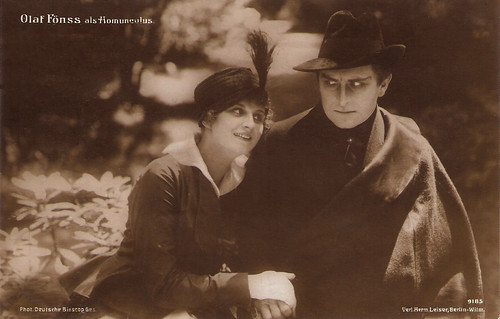
German postcard by Verlag Hermann Leiser, Berlin-Wilm., no. 9185. Photo: DBG (Deutsche Bioscop-Gesellschaft). Publicity still for Homunculus, 1. Teil. Der künstliche Mensch/Homunculus (Otto Rippert, 1916) with Olaf Fönss as Homunculus and Aud Egede Nissen.

German postcard by Verleih Hermann Leiser, Berlin, no. 9186. Photo: DBG (Deutsche Bioscop-Gesellschaft). Publicity still for Homunculus, 2. Teil. Das geheimnisvolle Buch/Homunculus. The mysterious book (Otto Rippert, 1916).

German postcard by Verlag Herm. Leiser, Berlin, no. 9664. Sent by mail in 1917. Photo: DBG (Deutsche Bioscop-Gesellschaft). Publicity still for Homunculus 3. Die Liebeskomödie des Homunculus/The tragic love story of the Homunculus (Otto Rippert, 1916). The girl could be Ilse Lersen (Luise) or Erna Thiele (Anna). Before he wants to destroy the world, Homunculus wants to explore love.
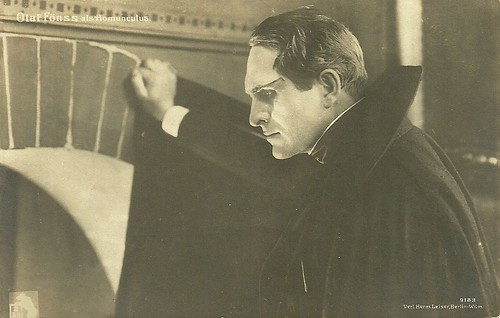
German postcard by Verlag Herm. Leiser, Berlin, no. 9183. Photo: DBG (Deutsche Bioscop-Gesellschaft). Publicity still for Die Liebeskomödie des Homunculus/The tragic love story of the Homunculus (Otto Rippert, 1916).
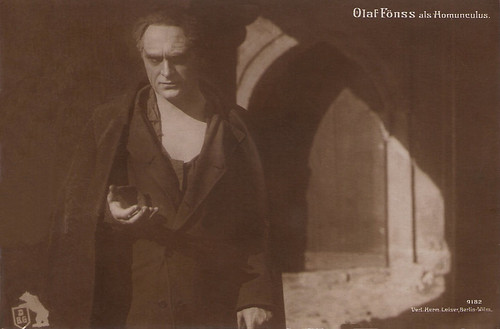
German postcard by Verlag Herm. Leiser, Berlin, no. 9182. Photo: DBG (Deutsche Bioscop-Gesellschaft). Publicity still for Homunculus, 5. Teil. Die Vernichtung der Menschheit/Homunculus. The Destruction of Mankind (Otto Rippert, 1916).
Wonderful photography
Homunculus was set up as a super-serial, composed of six feature-length episodes. It was meant to play not only as a serial, but as a series.
Bob Lipton notes at IMDb that the film "has some wonderful photography [by Carl Hoffmann] (notice the strong use of framing not by irising, as was still very common at this time, but by using structure and set decoration to change the effective frame size) and toning (a process in which the black silver nitrate is replaced by other compounds with colors, resulting in white whites, black blacks but colors instead of grays)".
The story asks the question: is the soul born with the body, or the gift of god?
After making Homunculus, Olaf Fönss did not stay in Berlin. He was called back to play in Danish films after Danish star Valdemar Psilander had committed suicide.
But his German film serial was a huge success during the dark years of World War I, and Homunculus would inspire many later artificial human films, including James Whale's horror classic Frankenstein (1931) featuring Boris Karloff as Frankenstein's monster.
Prints of Homunculus exist in the George Eastman House film archive (only a 1920 coloured re-release version of about 75 min. with Italian language intertitles, preserved in 2002); in the Bundesarchiv-Filmarchiv (one black & white episode); in the Národní Filmovy Archiv (one black & white episode); and in the Cinémathèque Suisse film archive (250 metres).

German postcard by Verlag Herm. Leiser, Berlin, no. 5017.
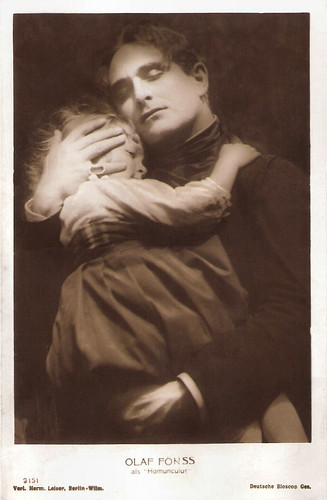
German postcard by Verleih Hermann Leiser, Berlin, no. 9151. Photo: DBG (Deutsche Bioscop-Gesellschaft). Publicity still for Homunculus, 1. Teil/Homunculus (Otto Rippert, 1916).
Sources: Bob Lipton (IMDb), Stephen Prince (The Horror Film), Silent Era, Wikipedia, and IMDb.
No comments:
Post a Comment